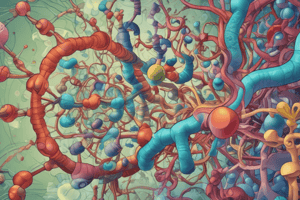Podcast
Questions and Answers
What are the majority of biological lipids and how does their nature help them function?
What are the majority of biological lipids and how does their nature help them function?
The majority of biological lipids are 'amphipathic' in nature, which helps them to act as effective barriers to more polar molecules in membranes.
How can fatty acids be classified and what are examples of essential fatty acids?
How can fatty acids be classified and what are examples of essential fatty acids?
Fatty acids can be classified as saturated or unsaturated and by chain length (short, medium, long). Examples of essential fatty acids include linoleic and linolenic acids.
What is the general structure of fatty acids and what is a common characteristic of 'n' in their structure?
What is the general structure of fatty acids and what is a common characteristic of 'n' in their structure?
The general structure of fatty acids is CH3(CH2)nCOOH, and 'n' is almost always even.
What are some examples of saturated fatty acids and what is their chain length?
What are some examples of saturated fatty acids and what is their chain length?
In nature, which type of fatty acids are slightly more abundant than saturated fatty acids? Where are they particularly abundant?
In nature, which type of fatty acids are slightly more abundant than saturated fatty acids? Where are they particularly abundant?
Flashcards
What are amphipathic lipids?
What are amphipathic lipids?
Lipids that have both a hydrophilic (water-loving) and a hydrophobic (water-fearing) region. This dual nature makes them ideal for forming barriers, like cell membranes, which separate the watery interior of a cell from the watery environment outside.
How are fatty acids classified?
How are fatty acids classified?
Fatty acids are classified based on the presence or absence of double bonds in their hydrocarbon chain. Saturated: no double bonds, Unsaturated: one or more double bonds.
What are essential fatty acids?
What are essential fatty acids?
Essential fatty acids are fatty acids that the body cannot synthesize and must be obtained from the diet. Examples include linoleic acid (omega-6) and linolenic acid (omega-3).
What is the general structure of fatty acids?
What is the general structure of fatty acids?
Signup and view all the flashcards
Are unsaturated or saturated fatty acids more abundant in nature?
Are unsaturated or saturated fatty acids more abundant in nature?
Signup and view all the flashcards
Study Notes
Lipids Overview
- Lipids are water-insoluble compounds.
- Most lipids are fatty acids or esters of fatty acids.
- Lipids are soluble in non-polar solvents such as petroleum ether, benzene, and chloroform.
Functions of Lipids
- Energy storage
- Structure of cell membranes
- Thermal insulation and cushioning
- Precursors of hormones (steroids and prostaglandins)
Classification of Lipids
- Fatty acids
- Neutral lipids
- Phospholipids and other complex lipids
Types of Lipids
Amphipathic Lipids
- All biological lipids are amphipathic
- Examples:
Fatty Acids
- Part of most lipids
Triacylglycerols
- Also known as neutral lipids
Glycerophospholipids
- Phospholipids and other complex lipids
Sphingolipids
- Distinct type of lipid
Waxes
- Type of lipid
Isoprene-based Lipids
- Includes steroids
- Examples: Prostaglandins, Leukotrienes
Studying That Suits You
Use AI to generate personalized quizzes and flashcards to suit your learning preferences.




